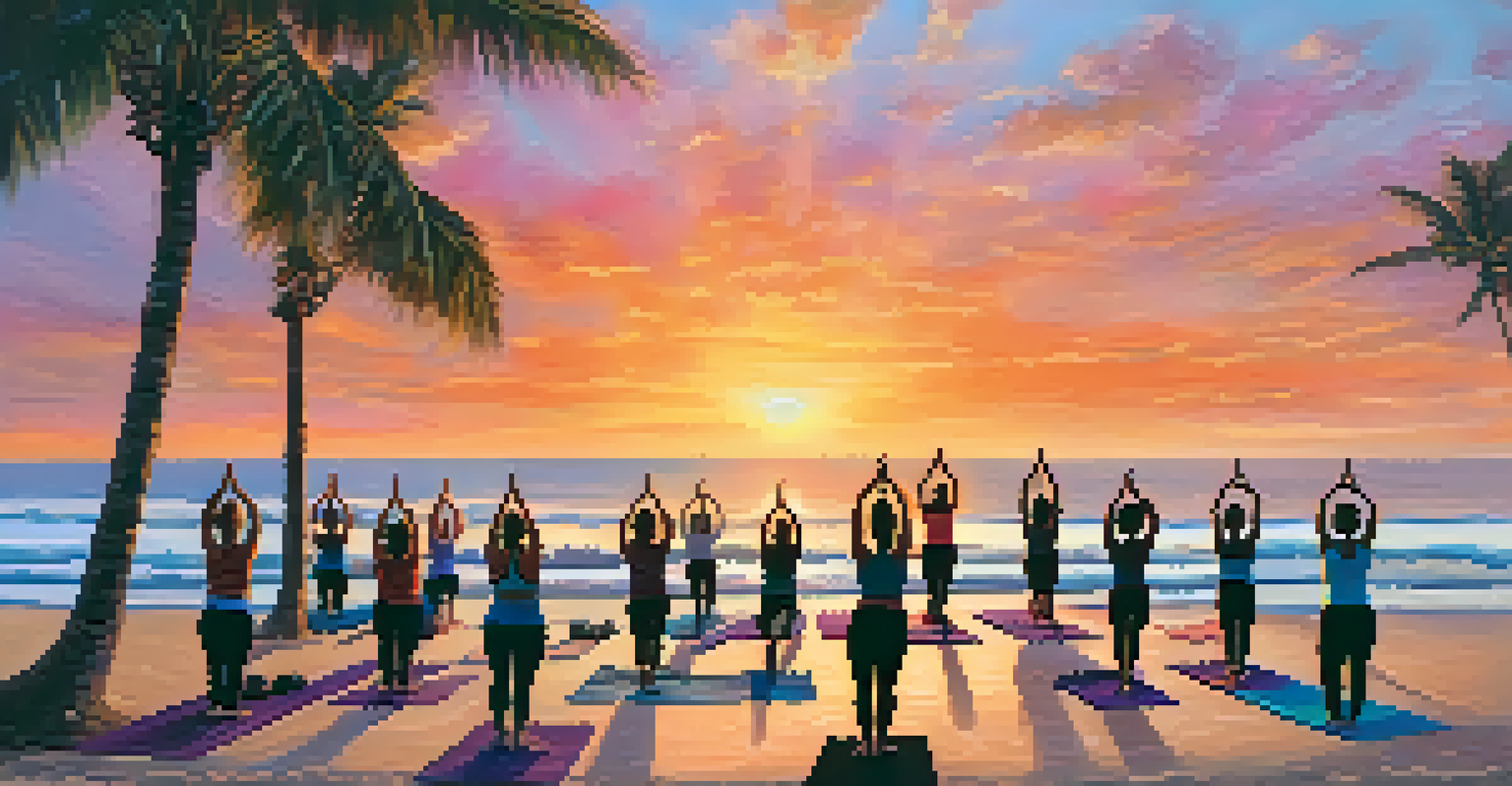The Evolution of Vinyasa Yoga: From Traditional to Modern Styles

Understanding Vinyasa Yoga: A Brief Overview
Vinyasa Yoga, often characterized by its fluid movements and breath synchronization, has gained immense popularity in recent years. Originating from the ancient practices of Hatha Yoga, it emphasizes the connection between breath and movement. This style is often referred to as 'flow' yoga because of its continuous and dynamic sequences.
Yoga is the journey of the self, through the self, to the self.
Unlike static postures, Vinyasa invites practitioners to link their movements with breath, creating a rhythmic experience. This approach not only enhances physical flexibility but also fosters mental clarity and focus. Think of it like a dance, where each breath marks a new step in a beautifully choreographed routine.
Over the years, Vinyasa has evolved to include various interpretations and adaptations, making it accessible to a wider audience. As more people seek holistic health benefits, the evolution of Vinyasa Yoga reflects a growing desire for both physical fitness and mindfulness.
The Roots of Vinyasa: Traditional Practices
To truly appreciate Vinyasa Yoga, it’s essential to look back at its traditional roots. The term 'Vinyasa' translates to 'to place in a special way,' which reflects the meticulous alignment and sequencing found in traditional practices. Early practitioners focused on static poses that emphasized strength, flexibility, and meditation.

Traditional Vinyasa was heavily influenced by the teachings of ancient yogis who valued discipline and control. Practices such as Ashtanga Yoga, developed by Pattabhi Jois, laid the groundwork for modern Vinyasa techniques by integrating specific sequences known as 'vinyasas' or transitions.
Vinyasa Yoga: Flow and Mindfulness
Vinyasa Yoga emphasizes the connection between breath and movement, creating a rhythmic practice that fosters both physical flexibility and mental clarity.
Understanding these foundational principles gives modern practitioners a richer context for their practice. It highlights how far yoga has come while also emphasizing the importance of respecting its origins.
The Shift to Modern Vinyasa Yoga
As yoga gained popularity in the West, a significant shift occurred in how Vinyasa was taught and practiced. Modern Vinyasa often embraces a more relaxed approach, allowing for creativity and personal expression. This shift has opened the door for a wider range of teaching styles and class formats, appealing to diverse audiences.
Inhale the future, exhale the past.
Today's classes may feature music, themed sequences, and even elements from other fitness disciplines, such as Pilates or dance. This evolution allows practitioners to experience yoga in a way that resonates with their personal preferences and lifestyles.
The modern Vinyasa class often feels less rigid and more exploratory, encouraging individuals to find their own rhythm. This transformation has made yoga more approachable, drawing in those who may have previously felt intimidated by traditional practices.
Influence of Technology on Vinyasa Yoga
Technology has dramatically influenced the evolution of Vinyasa Yoga, especially with the rise of online platforms. Virtual classes and instructional videos provide access to a wide range of instructors and styles from around the world. This convenience means that anyone can practice yoga in the comfort of their own home, regardless of their location.
Social media has also played a pivotal role in shaping modern Vinyasa by creating a vibrant community of practitioners who share their experiences, tips, and personal journeys. Platforms like Instagram have popularized yoga challenges and trends, inspiring countless individuals to join the movement.
Diversity and Inclusivity in Classes
Modern Vinyasa Yoga classes celebrate diversity, offering modifications to ensure that practitioners of all backgrounds and abilities feel welcomed and supported.
While the online experience offers flexibility and accessibility, it also raises questions about the authenticity of practice. Balancing the benefits of technology with the traditional aspects of Vinyasa is an ongoing conversation within the yoga community.
Diversity in Modern Vinyasa Yoga Classes
One of the most exciting developments in modern Vinyasa Yoga is the growing emphasis on diversity and inclusivity. Today's classes reflect a rich tapestry of backgrounds, body types, and abilities. This shift encourages a more welcoming environment where everyone can find their place on the mat.
Instructors are increasingly trained to offer modifications and variations, ensuring that all students feel supported. This approach not only enhances the physical practice but also fosters a sense of community and belonging. Think of it as a gathering where everyone brings their unique strengths and stories to share.
As the landscape of yoga continues to change, embracing diversity reminds us that yoga is for everyone. This inclusivity enriches the experience, making Vinyasa Yoga a unifying practice that transcends traditional boundaries.
The Role of Mindfulness in Vinyasa Yoga Today
Mindfulness has become a cornerstone of modern Vinyasa Yoga, blending physical movement with mental presence. Practitioners are encouraged to focus on their breath, thoughts, and feelings throughout the practice, creating a deeper connection to themselves. This holistic approach not only enhances physical performance but also promotes emotional well-being.
In a world filled with distractions, the mindful aspect of Vinyasa serves as a form of meditation in motion. Each transition between poses becomes an opportunity to cultivate awareness and presence. Imagine flowing through a series of movements while letting go of stress and distractions—this is the essence of mindful Vinyasa.
Technology's Impact on Practice
The rise of online platforms has made Vinyasa Yoga more accessible, allowing practitioners to engage with a global community while navigating the balance between modern convenience and traditional practice.
As more people seek balance in their fast-paced lives, the integration of mindfulness into Vinyasa Yoga offers a practical tool for achieving calm and clarity. This evolution reflects a broader trend of prioritizing mental health alongside physical fitness.
Looking Ahead: The Future of Vinyasa Yoga
As Vinyasa Yoga continues to evolve, it will likely embrace even more innovations and adaptations. Future trends may include the incorporation of advanced technologies, such as virtual reality or augmented reality, to enhance the practice experience. This could open new avenues for accessibility and engagement for practitioners worldwide.
Moreover, as wellness becomes increasingly prioritized, Vinyasa may expand its role in holistic health initiatives, integrating aspects of nutrition, mental health, and community support. The future may see Vinyasa Yoga as a central component of preventive health strategies, promoting overall well-being.

Ultimately, the evolution of Vinyasa Yoga reflects the changing needs and desires of practitioners. As it adapts to our modern lives, it will continue to inspire and empower individuals on their unique journeys toward health and self-discovery.